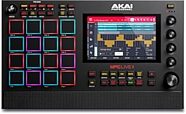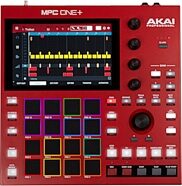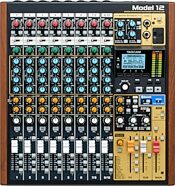
Moog Minimoog Model D Analog Synthesizer
Meet the new Minimoog Model D! Moog's update to their 1970s-era analog synthesizer adds a dedicated analog LFO, MIDI I/O, a mixer overload mod and more.
Moog Music Minimoog Voyager Anniversary Edition Analog Synthesizer
No longer available at zZounds
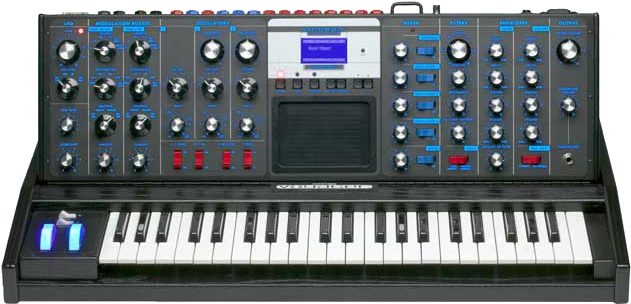
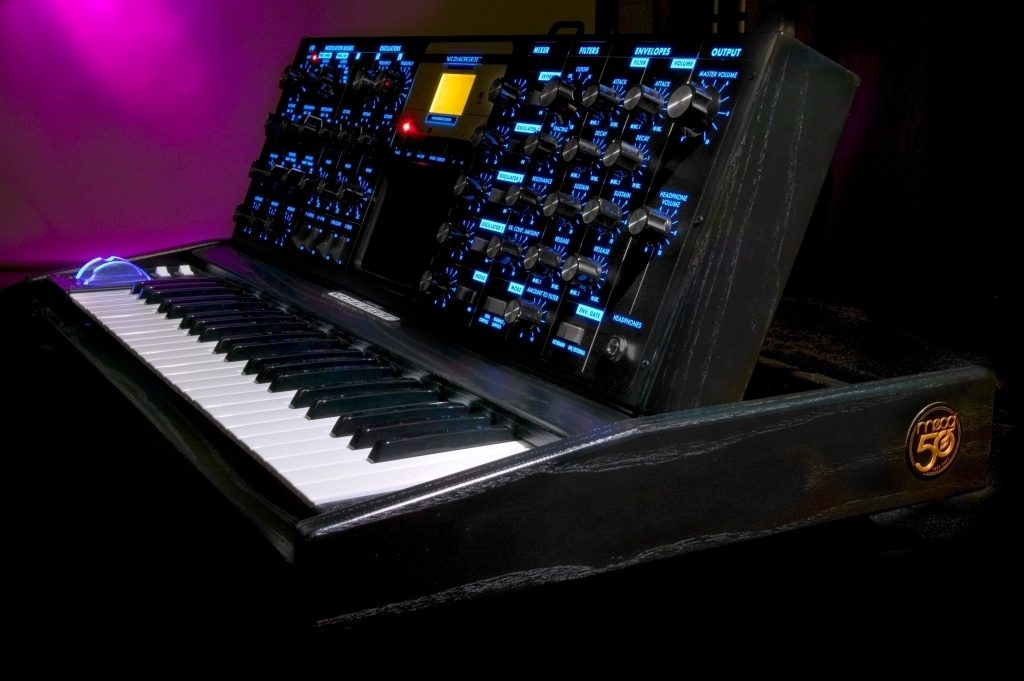


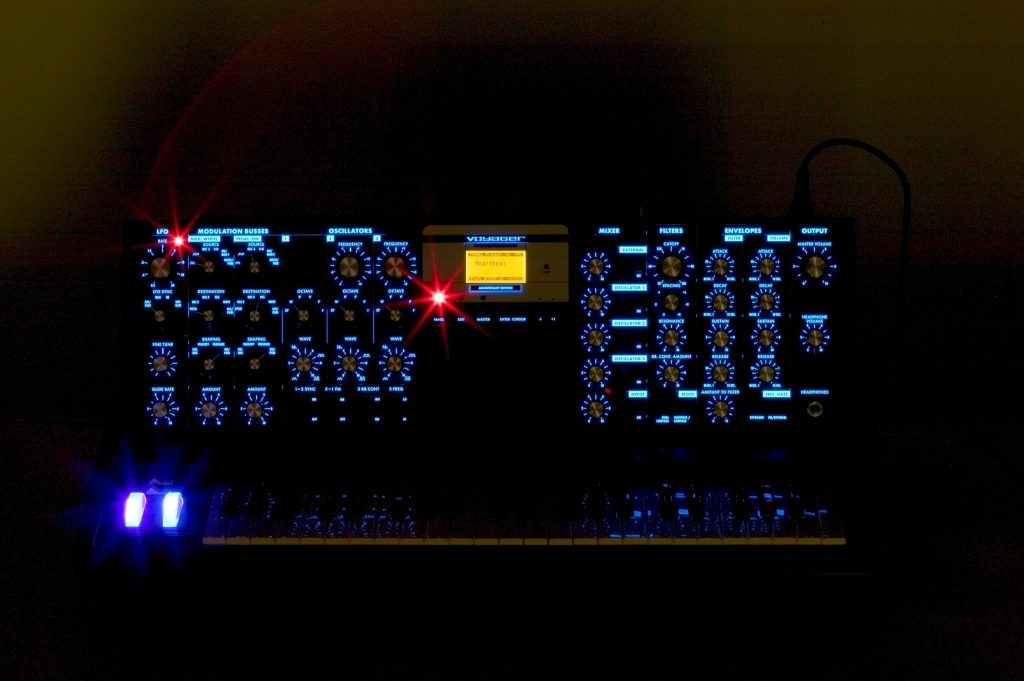
All analog. 3 oscillators. 2 filters. Extensive routing options. Signed models are signed by Bob Moog.
Overview
The Minimoog Voyager Anniversary Edition is a limited edition of the award-winning Minimoog Voyager analog synthesizer housed in a black lacquered wooden cabinet with an amazing blue backlit front panel. Whether this beauty is on the stage or in the studio, be prepared to see the jaws drop!
The Minimoog Voyager is an all-analog monophonic synthesizer designed by Bob Moog, which features the real moog sound and includes extensive modulation routings, MIDI and patch storage capabilities. The warmth and fatness of the sound of this instrument is unsurpassed. We invite you to compare the sound of the Voyager to other synths -- none can equal its responsiveness and superlative sound.
With 3 ultra-stable analog oscillators, dual Moog filters, and the punchiest analog envelope generators, players, audio engineers, and analog synthesis aficionados will find this to be an investment that will never go out of style. With a universe of sounds lurking beneath its stunning exterior, the musician who seeks to explore the outer limits of sound will always be rewarded.
The Anniversary Edition features a new bank of presets from outstanding Moog players such as Aron Magner (with Disco Biscuits), Chad Hugo (with the Neptunes), Darrell Diaz (with Herbie Hancock), Frank Lucas (with the Neil Zaza band), Fred Wreck (with Snoop Dogg), Gabrial McNair (with No Doubt), Geoffrey Keezer (with Christian McBride), Herbie Hancock, Khari Simmons (with India.Arie), James Lumb (with Electric Skychurch), Jamie… read more Muhoberac (session ace), Joseph Rivers (of the Audio Playground Synthesizer museum), Neil Palmer, Printz Board (Black-Eyed Peas), Randy Cantor (keyboards on Ricky Martin's hits), Rick Wakeman, and Roger Manning, Jr. (with Beck, the Moog Cookbook), plus a selection of presets cooked up at the Moog factory.
The Anniversary Edition is be a limited edition of the Minimoog Voyager - available only in 2004.
Features
The Minimoog Voyager Synthesizer is a monophonic (one note at a time) analog performance synthesizer. It incorporates virtually all of the sound resources and functions of the original Model D Minimoog, which was produced by Moog Music, Inc. from 1970 to 1982. It has many new additional features, including a three-dimensional touch surface, MIDI IN and MIDI OUT implementation, extensive patching facilities, and a large number of new panel features.
The signal path starts with a bank of three wide-range, high-stability voltage controlled oscillators, one noise source, and one audio preamplifier for externally-applied audio signals. The sound modifiers are two Moog filters and one stereo VCA (Voltage Controlled Amplifier). Modulation sources are two ADSR (Attack Decay Sustain Release) envelope generators and one multi-waveform LFO (Low Frequency Oscillator). Control devices include a 44-key keyboard with velocity and after-pressure outputs, pitch bend and modulation wheels, a three dimensional touch surface, and many control/pedal input jacks.
The Minimoog Voyager has a hinged, multi-position panel and a solid hardwood cabinet. The power supply accepts any power voltage from 100 volts to 240 volts.
Oscillators Module
Three wide-range, high stability VCOs (Voltage Controlled Oscillators) with continuously-variable waveforms.
-- Frequency controls (2) vary the frequencies of oscillators #2 and #3 over a +/-7 semitone range with respect to oscillator #1.
-- Octave selectors (3) set the frequency ranges of the oscillators in six octave steps.
-- Wave controls (3) provide continuous control over the waveforms of the oscillators; from triangular to sawtooth to square to narrow rectangular.
-- 1-2 SYNC switch synchronizes the oscillator #2 waveform to the frequency of oscillator #1, for dramatic timbral effects.
-- 3-1 FM switch provides linear frequency modulation of oscillator #1 by oscillator #3.
-- 3 KB CONT switch disconnects oscillator #3 from control by the keyboard, thereby enabling it to function as a drone.
-- 3 FREQ switch lowers the frequency of oscillator #3 into the sub-audio range, thereby enabling it to function as a low frequency audio or modulating oscillator.
Mixer Module
Five-input mixer for combining the audio sources prior to filtering.
-- Input level controls (5) adjust the relative levels of the oscillator, noise, and external audio input signals.
-- Input switches (5) enable the player to quickly switch individual audio signals in and out.
-- External level LED enables the player to set the correct external audio signal level.
Filters Module
Dual mode filter module includes dual lowpass and highpass-lowpass filtering. Dual lowpass mode consists of two Moog lowpass-resonant filters in parallel, one per output channel. Highpass-lowpass mode consists of a Moog lowpass filter in series with a highpass filter.
-- Cutoff control sweeps the frequencies of both filters throughout the audio range.
-- Spacing control sets the spacing between the frequencies of the two filters, over a +/-3 octave range.
-- Resonance control adjusts the resonance of both filters, from none (pure lowpass response) to filter oscillation.
-- KB Cont. Amount control sets how much the filters open and close as the player presses different keys on the keyboard.
-- Dual lowpass/highpass-lowpass switch selects between dual lowpass operation or highpass-lowpass operation.
Envelopes Module
The Envelopes Module generates two wide-range ADSR (Attack Decay Sustain Release) envelopes. The Filter Envelope sweeps the filter and is available for modulation shaping. The Volume Envelope shapes the overall volume.
-- Attack controls (2) determine the attack times of the envelopes.
-- Decay controls (2) determine the decay time constants of the envelopes.
-- Sustain controls (2) determine the sustain levels of the envelopes.
-- Release controls (2) determine the release time constants of the envelopes.
-- Amount to filter control determines how much the filter envelope will open and close the filter, from full negative (inverted envelope) to full positive (non-inverted envelope).
-- Envelope gate switch selects whether the envelopes will be on, triggered by the keyboard, or by an externally-applied gate.
LFO Module
Low Frequency Oscillator generates triangular, square, Sample & Hold, and smoothed Sample & Hold waveforms for use as modulating signals.
-- Rate control sets the LFO rate over the range 0.2 Hz (one cycle every five seconds) to 50 Hz (fifty times a second).
-- Sync selector selects LFO synchronization source to be from the keyboard gate, external envelope gate, external gate, or off (no synchronization).
-- Rate LED provides visual indication of the LFO rate.
Modulation Busses Module
Selects the sources, destinations, and shaping signals for the Mod Wheel bus and the Ext Pedal/On bus.
-- Source selectors (2) selects the modulation source from the LFO triangle or square waveforms, oscillator #3, sample and hold, the external modulation input (Mod2) or noise.
-- Destination selectors (2) selects the modulation destination from all the audio oscillators, just oscillator #2, just oscillator #3, the filter cutoff frequencies, the oscillator waveforms, or LFO Rate.
-- Shaping selectors (2) selects the key pressure signal, filter envelope, note-on velocity or on to shape the modulation signal on that bus.
-- Amount controls (2) sets the overall modulation amount for each bus.
Output Module
-- Master volume control sets the overall level of the instrument's audio outputs.
-- Headphone volume control sets the overall level of the headphone output.
-- Headphones jack: 1/4 in. tip-ring-sleeve phone jack for regular headphones.
Glide and Fine Tune Module
-- Glide varies the speed at which the keyboard voltage changes, from instantaneous to several seconds.
-- Fine Tune adjusts the overall tuning of the instrument.
V 1.5 Software Capabilities
Voyager Software developed by Rudi Linhard of Lintronics.
Rudi is also responsible for the software development of the LAMM (Lintronics Advanced Memorymoog); the LMC (Lintronics MIDI Converter for minimoog and other vintager analog synthesizers); and the Ethervox MIDI theremin.
-- Front panel storage and recall: except for the Fine Tuning control, the settings of all front panel controls, selectors, and switches are stored in the nonvolatile digital memory. A total of one hundred twenty eight front panel presets may be stored for instant recall.
-- Transmission and reception of keyboard data via MIDI: polyphonic note-on and note-off with velocity can be transmitted (note numbers 53-96). The Voyager responds to note-on (0-127) messages monophonically user-defineable note priority. The Voyager's front panel controls respond to MIDI CCs.
-- Uploading and downloading of banks of settings via MIDI: Program banks may be uploaded and downloaded via MIDI system exclusive. Individual presets may also be transferred by this method.
-- Updating of operating software via MIDI: The instrument's operating software can be updated via MIDI files (.syx sysex files).
Player Control Interfaces
-- 44-key keyboard produces pitch, gate, velocity, and pressure control outputs.
-- Wheels pitch wheel bends pitch over a range of up to +/-1 octave. Mod wheel controls the gain of the mod wheel bus.
-- Glide and release switches provide real-time on-off control over the glide and release functions.
-- Three-dimensional touch surface provides three continuously-variable control signals which are derived from the up-down and left-right position of the player's finger, and the amount of area with which the player makes contact to the surface.
Rear Jack Panel
Pedal/control inputs: These ten jacks have red nuts. They accept either expression pedals or control voltages, and control volume, pan, filter cutoff, waveform, pitch, mod 2 -- external modulation source, mod 1 - external control of the pedal mod bus, sample and hold in, envelopes rate and LFO rate.
Accessory port: the accessory port delivers the control voltage and gate signals generated inside the Voyager to a standard DB-25 connector. This is designed for use with the VX-351 Voyager CV Expander.
LFO Sync: a footswitch or gate applied to this input will reset the LFO waveform to the beginning of its cycle.
Envelopes Gate: a footswitch or gate applied to this input will start the envelopes.
Sample and Hold Gate: a gate signal applied to this jack will trigger a new sample and hold voltage.
Release: a foot switch plugged into this jack will have the same effect as depressing the corresponding switch on the left hand controller panel.
Mixer Ext In: plug any instrument-level or line-level audio signal in this jack to combine with the oscillator and noise signals prior to filtering.
Mix Out/Filter Audio In: the output of the audio mixer appears here, before being fed to the filter. Normally, the mixer output is bridged directly to the filter input. If you plug something into this jack, that breaks the normal connection. Using a standard insert cable (1/4" TRS plug to two 1/4" TS plugs) this jack can be used as an effects loop for external processing of the mix before it goes to the filter.
Left (Mono) and Right Audio Outputs: the audio outputs are 1/4 in. unbalanced outputs. The two output channels are summed to mono when only the left (mono) output is used.
12V Lamp: the BNC Lamp Socket provides 12VDC for a gooseneck lamp.
MIDI In, Thru, and Out connectors: standard MIDI connectors for interfacing with other MIDI gear.
Power Input: the Voyager's power input accepts a standard power cable. The Voyager works from 100-250 VAC, 50-60 Hz.
Dimensions: 30 1/2 in. wide X 18 in. deep X 3 in. high (when flat) 12 in. high when fully upright.
Weight: 40 lbs. read less
The Minimoog Voyager is an all-analog monophonic synthesizer designed by Bob Moog, which features the real moog sound and includes extensive modulation routings, MIDI and patch storage capabilities. The warmth and fatness of the sound of this instrument is unsurpassed. We invite you to compare the sound of the Voyager to other synths -- none can equal its responsiveness and superlative sound.
With 3 ultra-stable analog oscillators, dual Moog filters, and the punchiest analog envelope generators, players, audio engineers, and analog synthesis aficionados will find this to be an investment that will never go out of style. With a universe of sounds lurking beneath its stunning exterior, the musician who seeks to explore the outer limits of sound will always be rewarded.
The Anniversary Edition features a new bank of presets from outstanding Moog players such as Aron Magner (with Disco Biscuits), Chad Hugo (with the Neptunes), Darrell Diaz (with Herbie Hancock), Frank Lucas (with the Neil Zaza band), Fred Wreck (with Snoop Dogg), Gabrial McNair (with No Doubt), Geoffrey Keezer (with Christian McBride), Herbie Hancock, Khari Simmons (with India.Arie), James Lumb (with Electric Skychurch), Jamie… read more Muhoberac (session ace), Joseph Rivers (of the Audio Playground Synthesizer museum), Neil Palmer, Printz Board (Black-Eyed Peas), Randy Cantor (keyboards on Ricky Martin's hits), Rick Wakeman, and Roger Manning, Jr. (with Beck, the Moog Cookbook), plus a selection of presets cooked up at the Moog factory.
The Anniversary Edition is be a limited edition of the Minimoog Voyager - available only in 2004.
Features
The Minimoog Voyager Synthesizer is a monophonic (one note at a time) analog performance synthesizer. It incorporates virtually all of the sound resources and functions of the original Model D Minimoog, which was produced by Moog Music, Inc. from 1970 to 1982. It has many new additional features, including a three-dimensional touch surface, MIDI IN and MIDI OUT implementation, extensive patching facilities, and a large number of new panel features.
The signal path starts with a bank of three wide-range, high-stability voltage controlled oscillators, one noise source, and one audio preamplifier for externally-applied audio signals. The sound modifiers are two Moog filters and one stereo VCA (Voltage Controlled Amplifier). Modulation sources are two ADSR (Attack Decay Sustain Release) envelope generators and one multi-waveform LFO (Low Frequency Oscillator). Control devices include a 44-key keyboard with velocity and after-pressure outputs, pitch bend and modulation wheels, a three dimensional touch surface, and many control/pedal input jacks.
The Minimoog Voyager has a hinged, multi-position panel and a solid hardwood cabinet. The power supply accepts any power voltage from 100 volts to 240 volts.
Oscillators Module
Three wide-range, high stability VCOs (Voltage Controlled Oscillators) with continuously-variable waveforms.
-- Frequency controls (2) vary the frequencies of oscillators #2 and #3 over a +/-7 semitone range with respect to oscillator #1.
-- Octave selectors (3) set the frequency ranges of the oscillators in six octave steps.
-- Wave controls (3) provide continuous control over the waveforms of the oscillators; from triangular to sawtooth to square to narrow rectangular.
-- 1-2 SYNC switch synchronizes the oscillator #2 waveform to the frequency of oscillator #1, for dramatic timbral effects.
-- 3-1 FM switch provides linear frequency modulation of oscillator #1 by oscillator #3.
-- 3 KB CONT switch disconnects oscillator #3 from control by the keyboard, thereby enabling it to function as a drone.
-- 3 FREQ switch lowers the frequency of oscillator #3 into the sub-audio range, thereby enabling it to function as a low frequency audio or modulating oscillator.
Mixer Module
Five-input mixer for combining the audio sources prior to filtering.
-- Input level controls (5) adjust the relative levels of the oscillator, noise, and external audio input signals.
-- Input switches (5) enable the player to quickly switch individual audio signals in and out.
-- External level LED enables the player to set the correct external audio signal level.
Filters Module
Dual mode filter module includes dual lowpass and highpass-lowpass filtering. Dual lowpass mode consists of two Moog lowpass-resonant filters in parallel, one per output channel. Highpass-lowpass mode consists of a Moog lowpass filter in series with a highpass filter.
-- Cutoff control sweeps the frequencies of both filters throughout the audio range.
-- Spacing control sets the spacing between the frequencies of the two filters, over a +/-3 octave range.
-- Resonance control adjusts the resonance of both filters, from none (pure lowpass response) to filter oscillation.
-- KB Cont. Amount control sets how much the filters open and close as the player presses different keys on the keyboard.
-- Dual lowpass/highpass-lowpass switch selects between dual lowpass operation or highpass-lowpass operation.
Envelopes Module
The Envelopes Module generates two wide-range ADSR (Attack Decay Sustain Release) envelopes. The Filter Envelope sweeps the filter and is available for modulation shaping. The Volume Envelope shapes the overall volume.
-- Attack controls (2) determine the attack times of the envelopes.
-- Decay controls (2) determine the decay time constants of the envelopes.
-- Sustain controls (2) determine the sustain levels of the envelopes.
-- Release controls (2) determine the release time constants of the envelopes.
-- Amount to filter control determines how much the filter envelope will open and close the filter, from full negative (inverted envelope) to full positive (non-inverted envelope).
-- Envelope gate switch selects whether the envelopes will be on, triggered by the keyboard, or by an externally-applied gate.
LFO Module
Low Frequency Oscillator generates triangular, square, Sample & Hold, and smoothed Sample & Hold waveforms for use as modulating signals.
-- Rate control sets the LFO rate over the range 0.2 Hz (one cycle every five seconds) to 50 Hz (fifty times a second).
-- Sync selector selects LFO synchronization source to be from the keyboard gate, external envelope gate, external gate, or off (no synchronization).
-- Rate LED provides visual indication of the LFO rate.
Modulation Busses Module
Selects the sources, destinations, and shaping signals for the Mod Wheel bus and the Ext Pedal/On bus.
-- Source selectors (2) selects the modulation source from the LFO triangle or square waveforms, oscillator #3, sample and hold, the external modulation input (Mod2) or noise.
-- Destination selectors (2) selects the modulation destination from all the audio oscillators, just oscillator #2, just oscillator #3, the filter cutoff frequencies, the oscillator waveforms, or LFO Rate.
-- Shaping selectors (2) selects the key pressure signal, filter envelope, note-on velocity or on to shape the modulation signal on that bus.
-- Amount controls (2) sets the overall modulation amount for each bus.
Output Module
-- Master volume control sets the overall level of the instrument's audio outputs.
-- Headphone volume control sets the overall level of the headphone output.
-- Headphones jack: 1/4 in. tip-ring-sleeve phone jack for regular headphones.
Glide and Fine Tune Module
-- Glide varies the speed at which the keyboard voltage changes, from instantaneous to several seconds.
-- Fine Tune adjusts the overall tuning of the instrument.
V 1.5 Software Capabilities
Voyager Software developed by Rudi Linhard of Lintronics.
Rudi is also responsible for the software development of the LAMM (Lintronics Advanced Memorymoog); the LMC (Lintronics MIDI Converter for minimoog and other vintager analog synthesizers); and the Ethervox MIDI theremin.
-- Front panel storage and recall: except for the Fine Tuning control, the settings of all front panel controls, selectors, and switches are stored in the nonvolatile digital memory. A total of one hundred twenty eight front panel presets may be stored for instant recall.
-- Transmission and reception of keyboard data via MIDI: polyphonic note-on and note-off with velocity can be transmitted (note numbers 53-96). The Voyager responds to note-on (0-127) messages monophonically user-defineable note priority. The Voyager's front panel controls respond to MIDI CCs.
-- Uploading and downloading of banks of settings via MIDI: Program banks may be uploaded and downloaded via MIDI system exclusive. Individual presets may also be transferred by this method.
-- Updating of operating software via MIDI: The instrument's operating software can be updated via MIDI files (.syx sysex files).
Player Control Interfaces
-- 44-key keyboard produces pitch, gate, velocity, and pressure control outputs.
-- Wheels pitch wheel bends pitch over a range of up to +/-1 octave. Mod wheel controls the gain of the mod wheel bus.
-- Glide and release switches provide real-time on-off control over the glide and release functions.
-- Three-dimensional touch surface provides three continuously-variable control signals which are derived from the up-down and left-right position of the player's finger, and the amount of area with which the player makes contact to the surface.
Rear Jack Panel
Pedal/control inputs: These ten jacks have red nuts. They accept either expression pedals or control voltages, and control volume, pan, filter cutoff, waveform, pitch, mod 2 -- external modulation source, mod 1 - external control of the pedal mod bus, sample and hold in, envelopes rate and LFO rate.
Accessory port: the accessory port delivers the control voltage and gate signals generated inside the Voyager to a standard DB-25 connector. This is designed for use with the VX-351 Voyager CV Expander.
LFO Sync: a footswitch or gate applied to this input will reset the LFO waveform to the beginning of its cycle.
Envelopes Gate: a footswitch or gate applied to this input will start the envelopes.
Sample and Hold Gate: a gate signal applied to this jack will trigger a new sample and hold voltage.
Release: a foot switch plugged into this jack will have the same effect as depressing the corresponding switch on the left hand controller panel.
Mixer Ext In: plug any instrument-level or line-level audio signal in this jack to combine with the oscillator and noise signals prior to filtering.
Mix Out/Filter Audio In: the output of the audio mixer appears here, before being fed to the filter. Normally, the mixer output is bridged directly to the filter input. If you plug something into this jack, that breaks the normal connection. Using a standard insert cable (1/4" TRS plug to two 1/4" TS plugs) this jack can be used as an effects loop for external processing of the mix before it goes to the filter.
Left (Mono) and Right Audio Outputs: the audio outputs are 1/4 in. unbalanced outputs. The two output channels are summed to mono when only the left (mono) output is used.
12V Lamp: the BNC Lamp Socket provides 12VDC for a gooseneck lamp.
MIDI In, Thru, and Out connectors: standard MIDI connectors for interfacing with other MIDI gear.
Power Input: the Voyager's power input accepts a standard power cable. The Voyager works from 100-250 VAC, 50-60 Hz.
Dimensions: 30 1/2 in. wide X 18 in. deep X 3 in. high (when flat) 12 in. high when fully upright.
Weight: 40 lbs. read less
Documents and Manuals
For support or warranty questions, please contact the manufacturer:
Phone: 828-251-0090
Email: techsupport@moogmusic.com
Web: https://moogmusicsupport.zendesk.com
Phone: 828-251-0090
Email: techsupport@moogmusic.com
Web: https://moogmusicsupport.zendesk.com
No longer available at zZounds
This is a carousel with product cards. Use the previous and next buttons to navigate.






